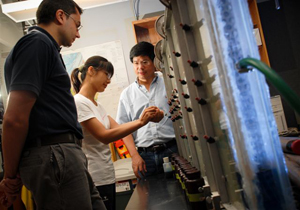Decades after Manhattan Project, Scientist’s Computer Model Key to Understanding Contamination
By Chris Bryant
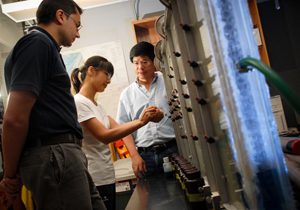
In the 1940s, 50,000 people followed the lure of jobs to the desert of southeastern Washington, near Richland. The nuclear reactor some of them constructed and operated, part of the nation’s then-secret Manhattan Project, produced the plutonium for the bomb dropped on Nagasaki, Japan, at the culmination of World War II.
Now, some 60 years later, Dr. Chunmiao Zheng’s chosen profession also draws him to the south end of the site, known as Hanford, where processing waste was disposed to the ground. He’s a University of Alabama hydrogeologist and part of a team of scientists who share a goal of solving why contamination in groundwater has persisted, despite predictions that it would flush from the system.
The researchers hope the lessons learned can be applied to sites outside Hanford, the nation’s most contaminated nuclear site.
The Hanford Site was once the location of multiple nuclear reactors and processing plants. Between 1944 – when uranium was first turned into plutonium at the site – and 1987 – when the last of Hanford’s reactors was shut down and clean-up began – eight additional reactors were constructed there. Today’s clean-up efforts at the site, near the banks of the Columbia River, are multiple and extensive. In total, the Department of Energy spends about $2 billion annually on clean-up at the site.
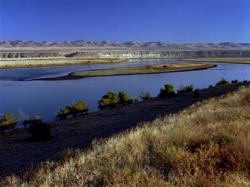
“Our goal is to understand how contaminants migrate in the subsurface, which is characterized by great complexities,” says Zheng. “And then apply that understanding to predictions of transport migration. If we can understand the conditions in which contaminants move and transform at Hanford, then we are in great position to apply the knowledge to other sites.”
The research group to which Zheng belongs is focused on a uranium plume – a body of groundwater at the site containing uranium levels exceeding safe drinking water standards. This plume is a result of a past practice of discharging wastes from nuclear fuels development in waste disposal ponds at the site from 1943 until 1975, according to the Pacific Northwest National Laboratory.
This national lab’s Dr. John Zachara leads a new, five-year, $13 million effort at a specific portion of the site, known as the Hanford 300 Area. It is one of three sites funded by a new U.S. Department of Energy Office of Science program that commits multi-investigator teams to perform large, benchmark-type experiments on formidable science issues. This new site is called Integrated Field-Scale Subsurface Research Challenge, or IFRC.
The Hanford IFRC team, which conducts extensive field experiments, involves more than a dozen co-principal investigators, including researchers from three other DOE national laboratories, the U.S. Geological Survey, Oregon State University and the University of California-Berkeley, in addition to the UA researchers.
The project recently completed installation of an innovative system of three dozen wells and instrumentation to initiate the field experiments. The subsurface surrounding the wells is being comprehensively characterized to enable a complete accounting of the processes that occur beneath the surface that contribute to the persistent groundwater contamination.
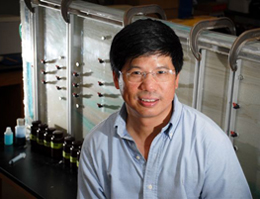
The 46-year-old Zheng was invited to join the multidisciplinary research team, in large part, because of the international success of a computer model he developed, a model that took shape in the late 1980s while he was working on his doctorate. Today, that model, known as MT3D, is used in more than 100 countries and is considered the de facto industry standard for predicting how groundwater contaminants will move.
Zheng says timing, ease of use and its ties to the U.S. Geological Survey all contribute to the success of the model – said to be the most widely used contaminant transport computer model in the world.
“Some people develop a very fancy computer model, but it may not be very applicable to solving real problems. I think that is one of the major strengths of MT3D, it is really very accessible to people working in the field.”
As for the other two factors, Zheng says there was an unmet need for such a model when he began developing it while a student at the University of Wisconsin, Madison. Upon completion, the model was released in the public domain by the Environmental Protection Agency and paired as a companion with the USGS flow model. Zheng has continuously improved the model since he came to UA in 1993. His collaborators include two UA mathematicians, Drs. Patrick Wang and Tsun Zee Mai.
In describing how his computer model works, the UA College of Arts and Sciences’ researcher suggests thinking of another computer model, one seen in action when you watch a newscast.
“When you see the weather forecast on the morning news, you see a color map, with movement. That is all from computer modeling. That is directly analogous to groundwater modeling.”
In Zheng’s version of a forecast, considerations such as the properties of the rocks surrounding the contaminated groundwater, likely chemical reactions, adsorption rates, decay and the concentration levels of the contaminant are all factored in via mathematical equations. Those theoretical results are then visualized through the use of maps depicting the underground areas.
“Computer modeling is an essential tool for any science, whether we are making weather predictions or economic forecasting,” Zheng says. “At the same time, computer modeling is nothing if you don’t have reality. We focus on combining field work with modeling. My group has been successful because we have several wonderful field sites where we have detailed instrumentation.”
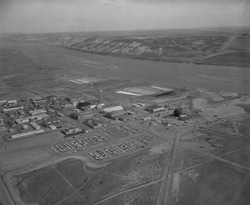
One of Zheng’s test sites is at the Air Force Base in Columbus, Miss, a test project funded by the National Science Foundation. There, just like at Hanford, multiple test wells, some 4-inches in diameter and up to 40 feet deep, are bored, and liquid tracers are injected. Unlike at Hanford, there is no contamination at the test site in Columbus. Extensive instrumentation at the site measures how the tracer material moves from one test well to another.
“Then, we refine the computer models to try and reproduce the experimental results. The idea is that if I can reproduce the experimental results, then I can make a prediction as to what is likely to happen over time” (at contaminated sites).
Based, in part, on those predictions, the scientists can then recommend the best ways to remediate a site. Typical options include pumping the contaminated water from the aquifer and treating it, injecting chemical agents to either immobilize the contaminants or produce a desired chemical reaction, or, in some cases, to leave it alone, allowing the contaminant levels to drop, over time, to an acceptable level.
The portion of the work that Zheng leads at UA for the IFRC is supported by some $600,000 of the grant. UA post-doctoral researcher Rui Ma is involved in the project as are graduate students Marco Bianchi and Guoliang Cao and international researchers Drs. Henning Prommer, of Australia, and Vincent Post of the Netherlands. Zheng also frequently collaborates with Dr. Geoffrey Tick, assistant professor of geological sciences at UA.
Zheng’s involvement with the DOE Office of Science project is expected to continue at least through 2012. He says he’s pleased with the opportunity to work on a project with such widespread implications.
“There are thousands and thousands of contaminated sites in the country. You cannot devote $13 million to each site. The idea is, we put in lots of money and get very detailed field data at this site, so we can answer our scientific questions with great confidence. Then, we can apply the knowledge to other sites where we don’t have so many data points.”
Further Reading
